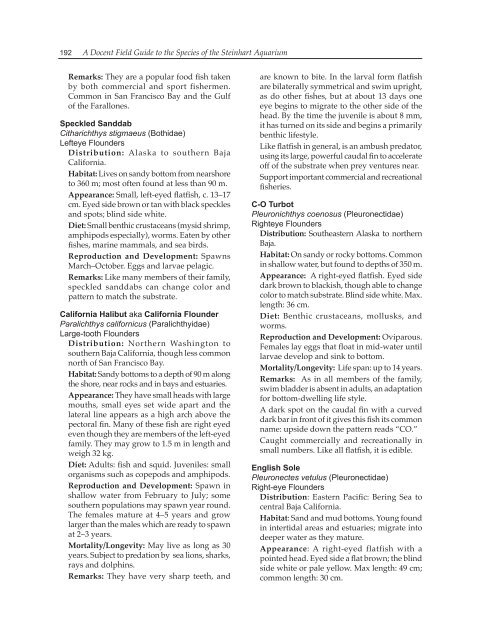THE STEINHART AQUARIUM - Gulf of Guinea Science ...
THE STEINHART AQUARIUM - Gulf of Guinea Science ...
THE STEINHART AQUARIUM - Gulf of Guinea Science ...
You also want an ePaper? Increase the reach of your titles
YUMPU automatically turns print PDFs into web optimized ePapers that Google loves.
192 A Docent Field Guide to the Species <strong>of</strong> the Steinhart Aquarium<br />
Remarks: They are a popular food fish taken<br />
by both commercial and sport fishermen.<br />
Common in San Francisco Bay and the <strong>Gulf</strong><br />
<strong>of</strong> the Farallones.<br />
Speckled Sanddab<br />
Citharichthys stigmaeus (Bothidae)<br />
Lefteye Flounders<br />
Distribution: Alaska to southern Baja<br />
California.<br />
Habitat: Lives on sandy bottom from nearshore<br />
to 360 m; most <strong>of</strong>ten found at less than 90 m.<br />
Appearance: Small, left-eyed flatfish, c. 13–17<br />
cm. Eyed side brown or tan with black speckles<br />
and spots; blind side white.<br />
Diet: Small benthic crustaceans (mysid shrimp,<br />
amphipods especially), worms. Eaten by other<br />
fishes, marine mammals, and sea birds.<br />
Reproduction and Development: Spawns<br />
March–October. Eggs and larvae pelagic.<br />
Remarks: Like many members <strong>of</strong> their family,<br />
speckled sanddabs can change color and<br />
pattern to match the substrate.<br />
California Halibut aka California Flounder<br />
Paralichthys californicus (Paralichthyidae)<br />
Large-tooth Flounders<br />
Distribution: Northern Washington to<br />
southern Baja California, though less common<br />
north <strong>of</strong> San Francisco Bay.<br />
Habitat: Sandy bottoms to a depth <strong>of</strong> 90 m along<br />
the shore, near rocks and in bays and estuaries.<br />
Appearance: They have small heads with large<br />
mouths, small eyes set wide apart and the<br />
lateral line appears as a high arch above the<br />
pectoral fin. Many <strong>of</strong> these fish are right eyed<br />
even though they are members <strong>of</strong> the left-eyed<br />
family. They may grow to 1.5 m in length and<br />
weigh 32 kg.<br />
Diet: Adults: fish and squid. Juveniles: small<br />
organisms such as copepods and amphipods.<br />
Reproduction and Development: Spawn in<br />
shallow water from February to July; some<br />
southern populations may spawn year round.<br />
The females mature at 4–5 years and grow<br />
larger than the males which are ready to spawn<br />
at 2–3 years.<br />
Mortality/Longevity: May live as long as 30<br />
years. Subject to predation by sea lions, sharks,<br />
rays and dolphins.<br />
Remarks: They have very sharp teeth, and<br />
are known to bite. In the larval form flatfish<br />
are bilaterally symmetrical and swim upright,<br />
as do other fishes, but at about 13 days one<br />
eye begins to migrate to the other side <strong>of</strong> the<br />
head. By the time the juvenile is about 8 mm,<br />
it has turned on its side and begins a primarily<br />
benthic lifestyle.<br />
Like flatfish in general, is an ambush predator,<br />
using its large, powerful caudal fin to accelerate<br />
<strong>of</strong>f <strong>of</strong> the substrate when prey ventures near.<br />
Support important commercial and recreational<br />
fisheries.<br />
C-O Turbot<br />
Pleuronichthys coenosus (Pleuronectidae)<br />
Righteye Flounders<br />
Distribution: Southeastern Alaska to northern<br />
Baja.<br />
Habitat: On sandy or rocky bottoms. Common<br />
in shallow water, but found to depths <strong>of</strong> 350 m.<br />
Appearance: A right-eyed flatfish. Eyed side<br />
dark brown to blackish, though able to change<br />
color to match substrate. Blind side white. Max.<br />
length: 36 cm.<br />
Diet: Benthic crustaceans, mollusks, and<br />
worms.<br />
Reproduction and Development: Oviparous.<br />
Females lay eggs that float in mid-water until<br />
larvae develop and sink to bottom.<br />
Mortality/Longevity: Life span: up to 14 years.<br />
Remarks: As in all members <strong>of</strong> the family,<br />
swim bladder is absent in adults, an adaptation<br />
for bottom-dwelling life style.<br />
A dark spot on the caudal fin with a curved<br />
dark bar in front <strong>of</strong> it gives this fish its common<br />
name: upside down the pattern reads “CO.”<br />
Caught commercially and recreationally in<br />
small numbers. Like all flatfish, it is edible.<br />
English Sole<br />
Pleuronectes vetulus (Pleuronectidae)<br />
Right-eye Flounders<br />
Distribution: Eastern Pacific: Bering Sea to<br />
central Baja California.<br />
Habitat: Sand and mud bottoms. Young found<br />
in intertidal areas and estuaries; migrate into<br />
deeper water as they mature.<br />
Appearance: A right-eyed flatfish with a<br />
pointed head. Eyed side a flat brown; the blind<br />
side white or pale yellow. Max length: 49 cm;<br />
common length: 30 cm.


